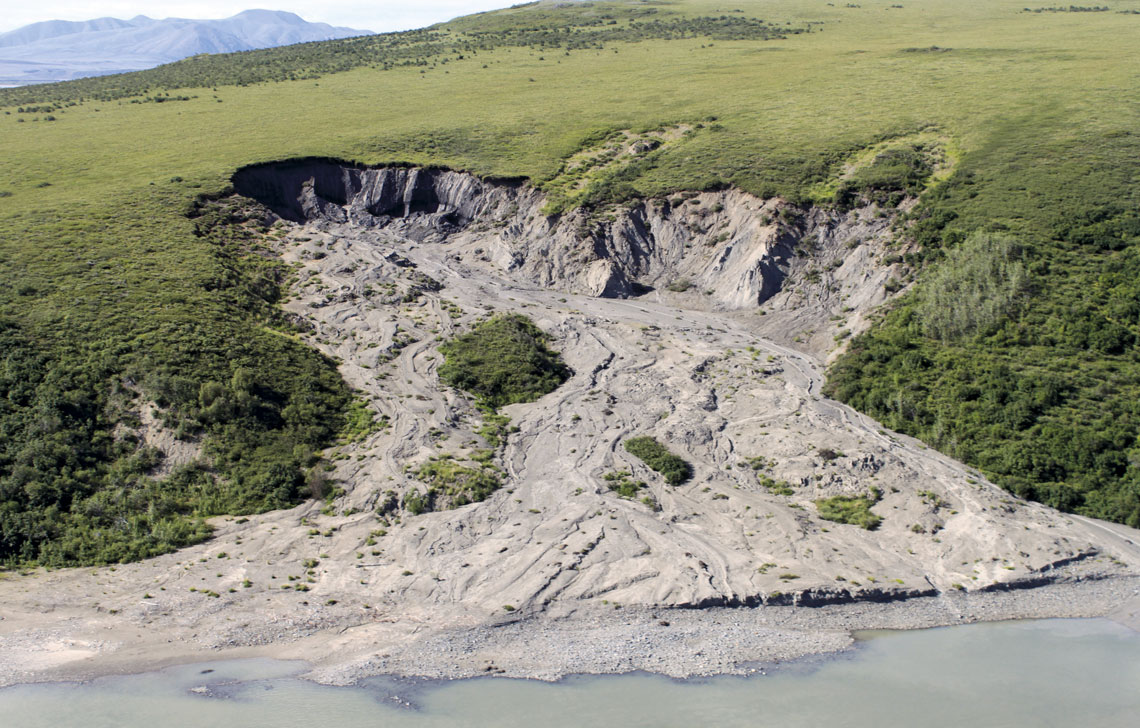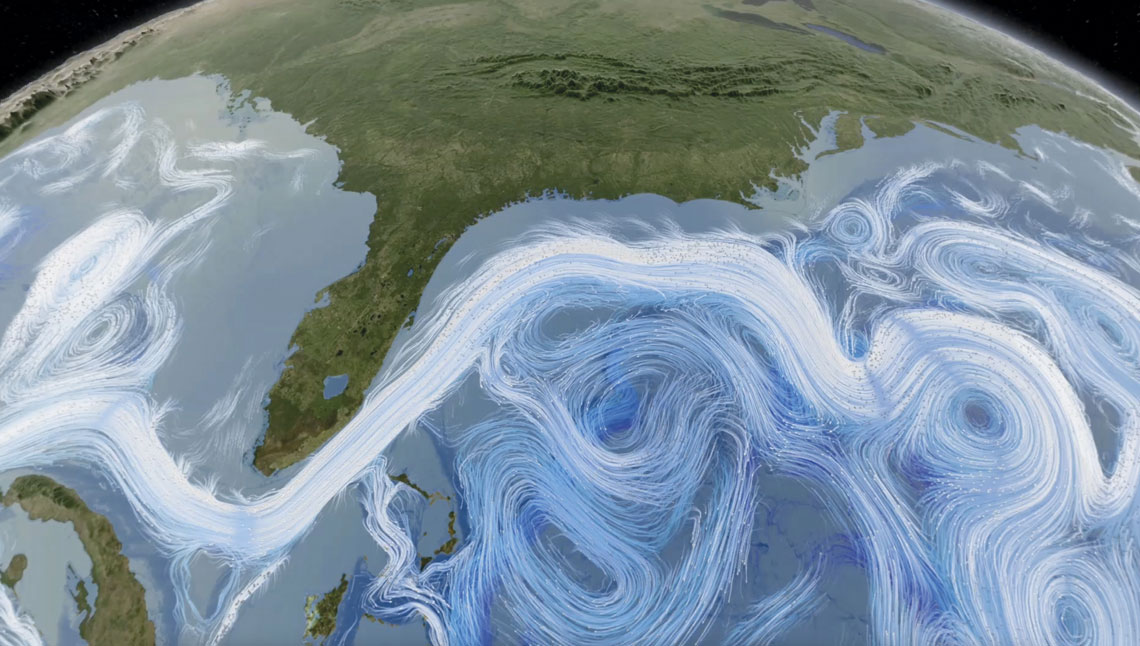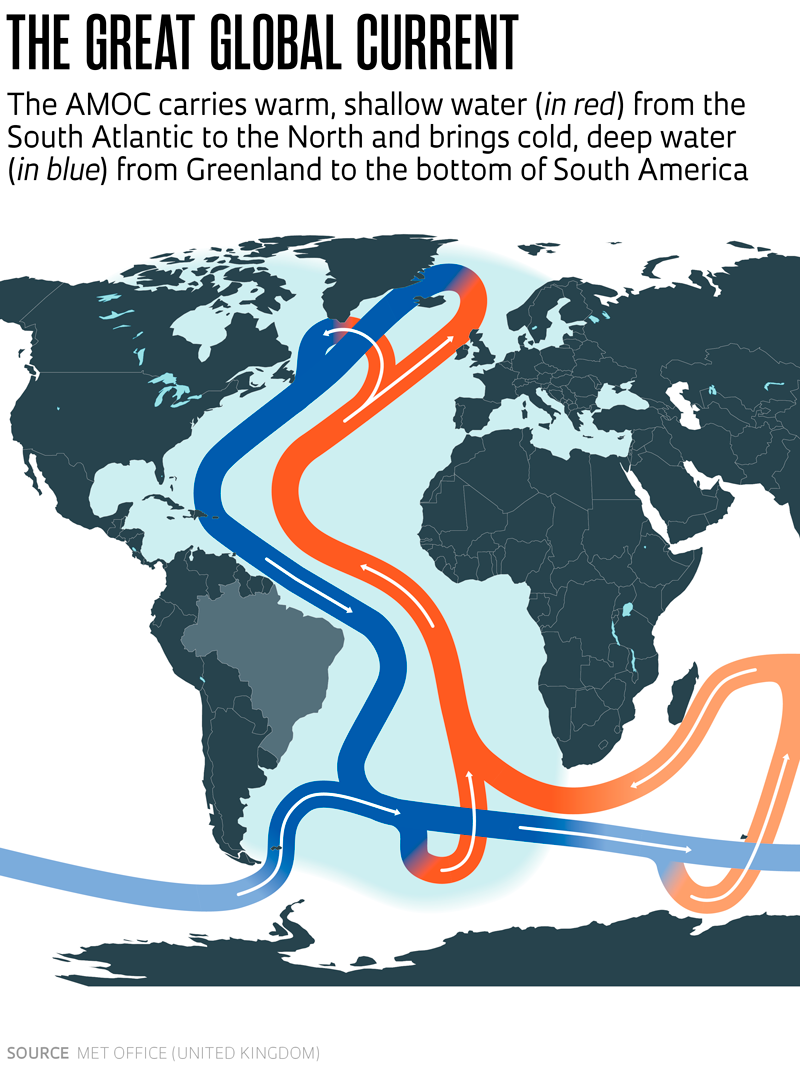In the 2004 blockbuster The Day After Tomorrow, melting of the Arctic ice cap causes a collapse of the North Atlantic’s current system. The change in the ocean’s circulation pattern is the starting point of a climate catastrophe that throws the planet into a new ice age. According to an article published in the journal Science Advances in February, the Atlantic section of the intercontinental ocean circulation is set to become so weak as a result of climate change that it may reach a point of no return.
The paper did not estimate when the change might occur — it could be a matter of years or decades. “We are moving closer [to the collapse], but we we’re not sure how much closer,” oceanographer René van Westen of Utrecht University, Netherlands, lead author of the study, told news agency Reuters. The article points out that a weakening of the current system — called the Atlantic Meridional Overturning Circulation (AMOC) — could cause major rainfall and temperature changes before the end of the century.
A slower AMOC would make the Northern Hemisphere colder over the coming decades, especially in North America and northern Europe. At the same time, the Southern Hemisphere would become even warmer. Although there would not be a new ice age as depicted in the over-the-top Hollywood movie, the implications of the phenomenon could be significant. The paper was based on climate modeling, which supported the observational and paleoclimatic evidence that the AMOC has become 15% slower in the last two decades and is now the weakest it has been this millennium.
According to the Intergovernmental Panel on Climate Change (IPCC) 2023 report, “there is medium confidence that there will not be an abrupt collapse before 2100, but if it were to occur, it would very likely cause abrupt shifts in regional weather patterns and major impacts on ecosystems and human activities.” The previous version of the report, from 2021, estimated that the chance of a complete collapse of the AMOC by the end of the century was between 4% and 46% in the scenario that greenhouse gas emissions were curbed (with global warming not much higher than current levels) and between 17% and 55% in the event that emissions rise significantly.
In an article published at the end of last year, scientists from Brazil and Germany used climate models to determine the potential effects a collapse of the AMOC would have on the Amazon rainforest. The study, published in the journal Communications Earth & Environment, indicates that in the worst-case scenario for climate change, a cessation of the current system could initially alleviate droughts in the region. “But this would only be a temporary delay in the process of the Amazon becoming a savanna,” says oceanographer Regina Rodrigues of the Climate Extremes Laboratory at the Federal University of Santa Catarina (UFSC), coauthor of the article.
Rodrigues estimates that the savannization process (when the dense and enclosed tropical forest is replaced with sparser vegetation and few trees, similar to a savanna) would be delayed by approximately a decade, intensifying in the 2050s instead of the 2040s. “This deferral would not be of any benefit to the Amazon and the slowdown of the AMOC would have major impacts on the global climate,” stresses the scientist.
The weakening of the AMOC is indirectly caused by global warming. Warmer temperatures cause more ice to melt in the Arctic region. This increases the amount of fresh water and decreases the salinity of the ocean around the south of Greenland, a region the AMOC passes through. The change makes the ocean current in the area slow down, potentially to the point that it would collapse entirely.
“When the sea surface is less salty, it freezes much more quickly,” explains Letícia Cotrim da Cunha, an oceanographer from Rio de Janeiro State University (UERJ). When it solidifies, the less saline water forms a fine layer of ice on the sea surface. “It’s like putting a barrier in the way of surface waters that should sink to the depths,” says the researcher.
The AMOC is essential to maintaining the planet’s current thermal balance. The upper portion of the AMOC transports warm water, which circulates on the surface because it is less dense, from the high latitudes of the South Atlantic to southern Greenland. There, the surface waters of the Weddell Sea lose heat to the atmosphere, become denser, and sink. “We call this process deep convection,” says César Barbedo Rocha, a physical oceanographer from the Oceanographic Institute at the University of São Paulo (IO-USP). The deeper waters are transported by the lower portion of the AMOC, which begins to circulate at a depth of 3,000 to 4,000 meters, where they begin their journey back to the high latitudes of the South Atlantic.
As this cold water passes through the tropics and reaches the south of the planet, some returns to the surface as a result of mixing with overlying warmer waters and strong westerly winds around Antarctica. This process is called upwelling. The AMOC is therefore like a global conveyor belt that carries cold waters at great depths from the Arctic to the Antarctic and warm waters on the surface from south to north.
Measurements taken in the Southern Hemisphere
To determine the true risk of the AMOC collapsing, more studies are needed. Direct measurements of the circulation system only began being taken in 2004. “We have around 20 years of data, which is very little in the time scale of a process as complex as the AMOC. The current can vary greatly from month to month and year to year, and these fluctuations have the potential to mask trends,” says Rocha. The two decades of direct observations do not clearly show the slowdown of the AMOC as indicated by climate modeling studies like the one described in Science Advances.
The measurements are not taken uniformly across the Atlantic basin: most are concentrated in the northern region of the ocean between Europe and the USA. Many scientists from the Northern Hemisphere say that the Gulf Stream, which begins in the Gulf of Mexico and travels along the east coast of the USA to Europe, is the current that best indicates variations in the AMOC. Some Brazilian oceanographers, however, argue that the weakening of the circulation is more observable in the Southern Hemisphere and near the tropics.

National Park Service / EUAPermafrost (normally frozen soil) melting in Alaska due to global warmingNational Park Service / EUA
Data on the AMOC has been collected off the Brazilian coast for the last 13 years. One project that aims to install sensors and measure AMOC heat variations is Sambar, funded by FAPESP and led by IO-USP’s Edmo Campos. By observing the changes around the 34.5th parallel south — which passes through the municipality of Chuí, in Rio Grande do Sul, and Cape Town, in South Africa — the project has already identified signs of temperature changes in deep waters in the region.
Physical oceanographer Ilana Wainer, a colleague of Campos at IO-USP, is also looking for “fingerprints” of a change in the AMOC’s balance. “Data from the past show that this weakening, or change in balance, can happen,” says the scientist. Her research topics include changes in the South Atlantic circulation during the Middle Pliocene (around 3 million years ago), when the earth’s average temperature was around 2 to 3 degrees Celsius (ºC) higher than in the preindustrial period of the mid-nineteenth century.
One of these fingerprints is the change that occurs in the bifurcation of the southern branch of the South Equatorial Current (which does not appear in the illustration on page 58) near the northeastern coast of Brazil. “If the fork moves further south, that means more is transported to the north, feeding the upper section of the AMOC. But, if it moves to the north, transport increases to the south, weakening the contribution to the upper AMOC,” explains Wainer. This mechanism could help explain why the current system is weakening. To function properly, the AMOC relies on the transportation of water from the South Atlantic to Greenland.
“We carried out investigations with numerical modeling data on different time scales and found the same behavior,” says oceanographer Fernanda Marcello, who is doing a postdoctorate at IO-USP under Wainer’s supervision. Simulations were analyzed for the last 22,000 years — since the end of the Last Glacial Maximum (ice age) — in addition to others focused on more recent periods, from the last 2,000 years. Based on the simulations and direct measurements, the current status of the AMOC is not yet completely clear, but the risk of the ocean circulation collapsing must not be ignored.
Projects
1. Interannual variability of meridional transport through the SAMOC transatlantic network (SAMBAR) (nº 17/09659-6); Grant Mechanism Thematic Project; Principal Investigator Edmo José Dias Campos (USP); Investment R$4,568,394.42
2. The Santos Bifurcation: Past and present (nº 20/14356-5). Grant Mechanism Thematic Project; FAPESP Program for Research into Global Climate Change. (PFPMCG); Principal Investigator Michel Michaelovitch de Mahiques (USP); Investment R$6,336,698.59.
Scientific articles
VAN WESTEN, R. M. et al. Physics-based early warning signal shows that AMOC is on tipping course. Science Advances. feb. 9, 2024.
NIAN, D. et al. A potential collapse of the Atlantic Meridional Overturning Circulation may stabilise eastern Amazonian rainforests. Communications Earth & Environment. dec. 12, 2023.
Republish

